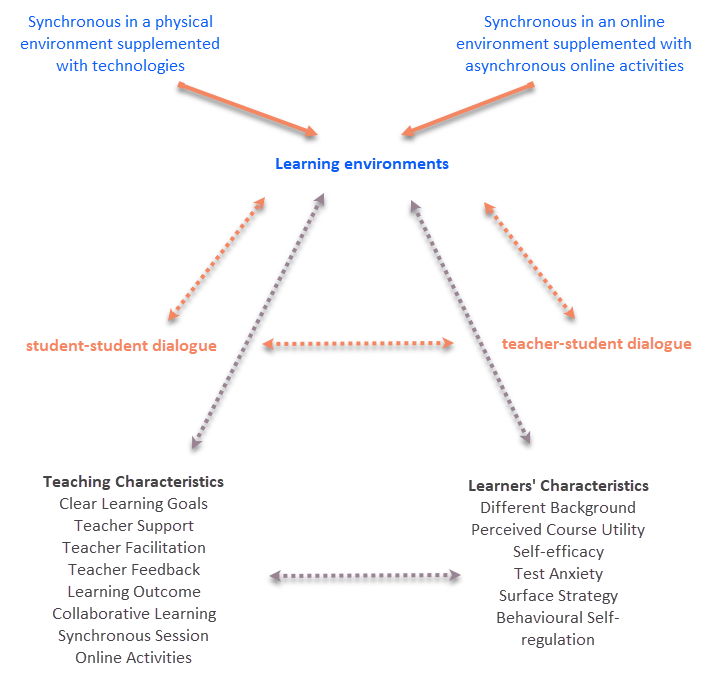Research Aim
Since the introduction of blended learning teachers have followed various instruction designs (e.g., flipped classroom, problem-based learning, collaborative learning and gamification) in order to enhance students’ engagement in learning process. Overall, a blended learning approach could be defined as a mix of online and face-to-face learning in pedagogically thoughtful manner supporting learning at anytime, anywhere, and at one’s own pace (Graham, 2006). Recent studies advocated that students could enhance their learning outcomes presenting higher cognitive engagement due to use of interactive learning technologies inside and outside learning environments (Yang 2016; Vo et al. 2017). Many researchers have found that online and face-to-face activities, teachers’ support, feedback process along with course clear goals and expectations play a crucial role in successful blended learning design (Milheim, 2012; Martin et al. 2018; Law et al. 2019).
During times of crisis or uncertainty, such as the recent global COVID-19 pandemic, hybrid learning has been adopted by many Higher Education institutions across the world allowing students to continue learning safely. Hybrid learning is a sub-category of blended learning supporting more additional offline or distance learning techniques. The goal is to apply the right mix of learning techniques to effectively teach the content and meet the learning needs of students. The additional learning techniques used are designed to enhance and reduce traditional face-to-face instruction (Raes, Detienne, Windey & Depaepe, 2020). Blended learning focuses solely on incorporating distance learning with traditional instruction, while hybrid learning focuses on incorporating any possible learning technique to best teach the content, no matter if it’s online or offline. Another differentiator is that blended learning focuses on an equal balance of distance learning and traditional instruction while hybrid learning typically leans more heavily on online or nontraditional instruction.
The aim of this project is to explore the effects of hybrid learning have on psychology and electrical engineering students’ learning engagement and academic performance over the three years of their studies. Specifically, the objectives of this investigation are to explore whether:
i. the curriculum activities and learning environment allow students to be actively engaged with their learning process;
ii. course goals, teaching delivery process and feedback process are associated with students’ performance; and
iii. students’ self-efficacy and self-regulation are linked to student learning engagement and academic performance.

Institutional Review Board Statement: This study was conducted according to the guidelines of the Declaration of Helsinki, and approved by the Institute of Life and Human Sciences Research Ethics Committee (School of Psychology) of the University of Liverpool (Protocol code: 8527 and Date of approval: 14/12/2020).
Questionnaire: Please find through Zenobo the questionnaire that was developed to support the aim of this study.
References
Graham, C. R. (2006). Blended learning systems: Definition, current trends, and future directions. In C. J. Bonk & C. R. Graham (Eds.), The handbook of blended learning: Global perspectives, local designs (pp. 3–21). San Francisco, CA: Pfeiffer.
Law, K. M., Geng, S., & Li, T. (2019). Student enrollment, motivation and learning performance in a blended learning environment: The mediating effects of social, teaching, and cognitive presence. Computers & Education, 136, 1–12.
Martin, F., Wang, C., & Sadaf, A. (2018). Student perception of helpfulness of facilitation strategies that enhance instructor presence, connectedness, engagement and learning in online courses. The Internet and Higher Education, 37, 52–65.
Milheim, K. L. (2012). Towards a better experience: Examining student needs in the online classroom through Maslow’s hierarchy of needs model. Journal of Online Learning and Teaching, 8(2), 159.
Raes, A., Detienne, L., Windey, I., & Depaepe, F. (2020). A systematic literature review on synchronous hybrid learning: gaps identified. Learning Environments Research, 23, 269–290.
Vo, H. M., Zhu, C., & Diep, N. A. (2017). The effect of blended learning on student performance at course-level in higher education: A meta-analysis. Studies in Educational Evaluation, 53, 17–28.
Yang, S. H. (2016). Conceptualizing effective feedback practice through an online community of inquiry. Computers & Education, 94, 162–177.